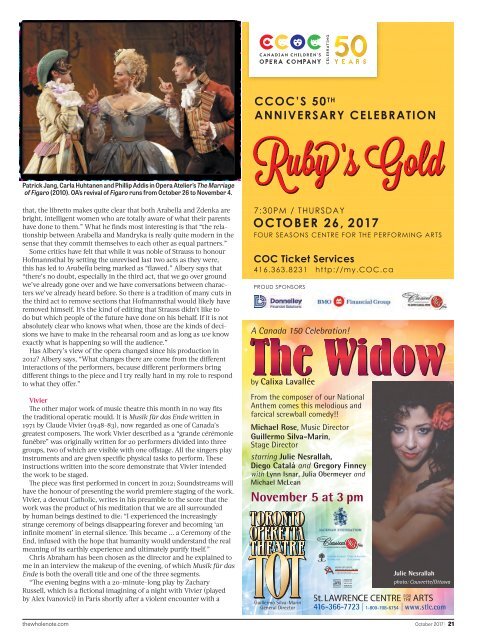Volume 23 Issue 2 - October 2017
In this issue: several local artists reflect on the memory of composer Claude Vivier, as they prepare to perform his music; Vancouver gets ready to host international festival ISCM World New Music Days, which is coming to Canada for the second time since its inception in 1923; one of the founders of Artword Artbar, one of Hamilton’s staple music venues, on the eve of the 5th annual Steel City Jazz Festival, muses on keeping urban music venues alive; and a conversation with pianist Benjamin Grosvenor, as he prepares for an ambitious recital in Toronto. These and other stories, in our October 2017 issue of the magazine.
In this issue: several local artists reflect on the memory of composer Claude Vivier, as they prepare to perform his music; Vancouver gets ready to host international festival ISCM World New Music Days, which is coming to Canada for the second time since its inception in 1923; one of the founders of Artword Artbar, one of Hamilton’s staple music venues, on the eve of the 5th annual Steel City Jazz Festival, muses on keeping urban music venues alive; and a conversation with pianist Benjamin Grosvenor, as he prepares for an ambitious recital in Toronto. These and other stories, in our October 2017 issue of the magazine.
Create successful ePaper yourself
Turn your PDF publications into a flip-book with our unique Google optimized e-Paper software.
Patrick Jang, Carla Huhtanen and Phillip Addis in Opera Atelier’s The Marriage<br />
of Figaro (2010). OA’s revival of Figaro runs from <strong>October</strong> 26 to November 4.<br />
that, the libretto makes quite clear that both Arabella and Zdenka are<br />
bright, intelligent women who are totally aware of what their parents<br />
have done to them.” What he finds most interesting is that “the relationship<br />
between Arabella and Mandryka is really quite modern in the<br />
sense that they commit themselves to each other as equal partners.”<br />
Some critics have felt that while it was noble of Strauss to honour<br />
Hofmannsthal by setting the unrevised last two acts as they were,<br />
this has led to Arabella being marked as “flawed.” Albery says that<br />
“there’s no doubt, especially in the third act, that we go over ground<br />
we’ve already gone over and we have conversations between characters<br />
we’ve already heard before. So there is a tradition of many cuts in<br />
the third act to remove sections that Hofmannsthal would likely have<br />
removed himself. It’s the kind of editing that Strauss didn’t like to<br />
do but which people of the future have done on his behalf. If it is not<br />
absolutely clear who knows what when, those are the kinds of decisions<br />
we have to make in the rehearsal room and as long as we know<br />
exactly what is happening so will the audience.”<br />
Has Albery’s view of the opera changed since his production in<br />
2012? Albery says, “What changes there are come from the different<br />
interactions of the performers, because different performers bring<br />
different things to the piece and I try really hard in my role to respond<br />
to what they offer.”<br />
Vivier<br />
The other major work of music theatre this month in no way fits<br />
the traditional operatic mould. It is Musik für das Ende written in<br />
1971 by Claude Vivier (1948-83), now regarded as one of Canada’s<br />
greatest composers. The work Vivier described as a “grande cérémonie<br />
funèbre” was originally written for 20 performers divided into three<br />
groups, two of which are visible with one offstage. All the singers play<br />
instruments and are given specific physical tasks to perform. These<br />
instructions written into the score demonstrate that Vivier intended<br />
the work to be staged.<br />
The piece was first performed in concert in 2012; Soundstreams will<br />
have the honour of presenting the world premiere staging of the work.<br />
Vivier, a devout Catholic, writes in his preamble to the score that the<br />
work was the product of his meditation that we are all surrounded<br />
by human beings destined to die: “I experienced the increasingly<br />
strange ceremony of beings disappearing forever and becoming ‘an<br />
infinite moment’ in eternal silence. This became ... a Ceremony of the<br />
End, infused with the hope that humanity would understand the real<br />
meaning of its earthly experience and ultimately purify itself.”<br />
Chris Abraham has been chosen as the director and he explained to<br />
me in an interview the makeup of the evening, of which Musik für das<br />
Ende is both the overall title and one of the three segments.<br />
“The evening begins with a 20-minute-long play by Zachary<br />
Russell, which is a fictional imagining of a night with Vivier (played<br />
by Alex Ivanovici) in Paris shortly after a violent encounter with a<br />
A Canada 150 Celebration!<br />
by Calixa Lavallée<br />
From the composer of our National<br />
Anthem comes this melodious and<br />
farcical screwball comedy!!<br />
Michael Rose, Music Director<br />
Guillermo Silva-Marin,<br />
Stage Director<br />
starring Julie Nesrallah,<br />
Diego Catalá and Gregory Finney<br />
with Lynn Isnar, Julia Obermeyer and<br />
Michael McLean<br />
November 5 at 3 pm<br />
Guillermo Silva-Marin<br />
General Director<br />
Julie Nesrallah<br />
photo: Couvrette/Ottawa<br />
416-366-77<strong>23</strong> | 1-800-708-6754 | www.stlc.com<br />
thewholenote.com <strong>October</strong> <strong>2017</strong> | 21


















